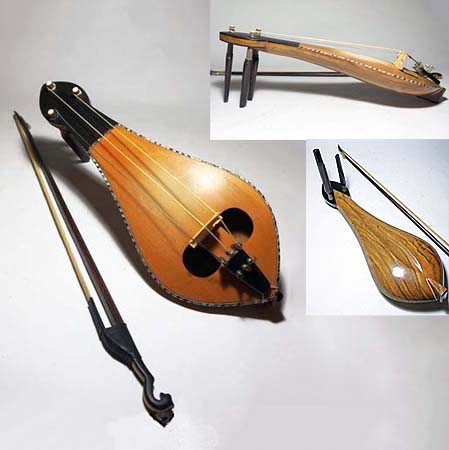
Owner: HWMC
Catalog#: ME-CHLT-11
Lutes
Turkey ‘Kemençe’ (Kementche of Laz)
Turkey/Greece
Turkish
Wood, steel strings, gut strings, mother-of-pearl, ebony, horsehair, metal
Mid 20th century
Length: 17.25 in, Width: 5.25 in, Depth: 4.75 in
Chordophones – Lutes
Kemenche or kemençe is a name used for various types of stringed bowed musical instruments having their origin in the Eastern Mediterranean, particularly in Armenia, Greece (called lyra), Iran, Turkey, Azerbaijan, and regions adjacent to the Black Sea. This kemençe is a bowed lute, with a bowl-shaped resonator, and comes from Turkey, where it is known as the “Kementche of Laz”. Its pear-shaped body, elliptical pegbox and neck are carved from a single piece of wood. On the soundboard are two D-shaped (semicircular) soundholes spaced between a movable bridge with one side of the bridge resting on the face of the instrument and the other just above the sound post inside close to the center. At the top, the three long lacquered pegs form a triangle on the flat peghead. The edges of the soundboard and resonator body are trimmed with mother-of-pearl and ebony inlay. The three strings (two gut and one steel) pass over the bridge and attach to a tailpiece that is tied to a small carved spike at the bottom. There are nuts/screws to equalize the vibrating lengths of the strings on the tailpiece.
The kemençe is played by the Muslim Mevlevi Sufi musicians to accompany their ayin ceremony. These are dance rituals notable for their whirling movements. It is also used in other Turkish art music and urban folk music. When played, the kemençe is held in a vertical position with the bottom resting on one knee or between both knees, while sitting. This position with the tuning head uppermost is called “braccio.” The bow is called yay (Turkish), or doksar (Greek). As the musician bows with one hand, the other hand stops the vibration of the strings to change pitch, by touching the strings with the side of their fingernails.
